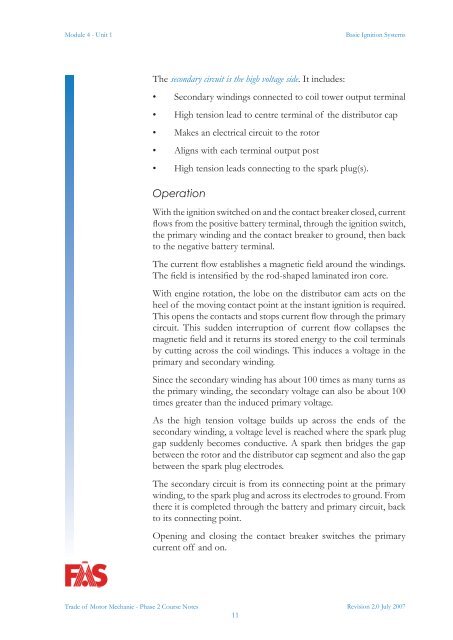Trade of Motor Mechanic - eCollege
Trade of Motor Mechanic - eCollege
Trade of Motor Mechanic - eCollege
Create successful ePaper yourself
Turn your PDF publications into a flip-book with our unique Google optimized e-Paper software.
Module 4 - Unit 1 Basic Ignition Systems<br />
<strong>Trade</strong> <strong>of</strong> <strong>Motor</strong> <strong>Mechanic</strong> - Phase 2 Course Notes<br />
The secondary circuit is the high voltage side. It includes:<br />
•<br />
•<br />
•<br />
•<br />
•<br />
Secondary windings connected to coil tower output terminal<br />
High tension lead to centre terminal <strong>of</strong> the distributor cap<br />
Makes an electrical circuit to the rotor<br />
Aligns with each terminal output post<br />
High tension leads connecting to the spark plug(s).<br />
Operation<br />
With the ignition switched on and the contact breaker closed, current<br />
flows from the positive battery terminal, through the ignition switch,<br />
the primary winding and the contact breaker to ground, then back<br />
to the negative battery terminal.<br />
The current flow establishes a magnetic field around the windings.<br />
The field is intensified by the rod-shaped laminated iron core.<br />
With engine rotation, the lobe on the distributor cam acts on the<br />
heel <strong>of</strong> the moving contact point at the instant ignition is required.<br />
This opens the contacts and stops current flow through the primary<br />
circuit. This sudden interruption <strong>of</strong> current flow collapses the<br />
magnetic field and it returns its stored energy to the coil terminals<br />
by cutting across the coil windings. This induces a voltage in the<br />
primary and secondary winding.<br />
Since the secondary winding has about 100 times as many turns as<br />
the primary winding, the secondary voltage can also be about 100<br />
times greater than the induced primary voltage.<br />
As the high tension voltage builds up across the ends <strong>of</strong> the<br />
secondary winding, a voltage level is reached where the spark plug<br />
gap suddenly becomes conductive. A spark then bridges the gap<br />
between the rotor and the distributor cap segment and also the gap<br />
between the spark plug electrodes.<br />
The secondary circuit is from its connecting point at the primary<br />
winding, to the spark plug and across its electrodes to ground. From<br />
there it is completed through the battery and primary circuit, back<br />
to its connecting point.<br />
Opening and closing the contact breaker switches the primary<br />
current <strong>of</strong>f and on.<br />
11<br />
Revision 2.0 July 2007
















